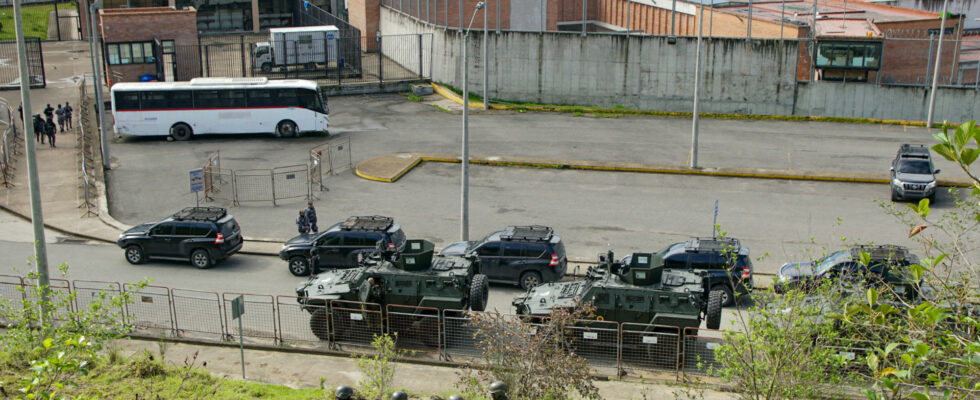The Ecuadorian army and police launched a vast operation on Sunday to regain control of the country’s prisons, after the release overnight of the 136 hostages, prison officials and guards, who had been held there for a week by mutineers. The army released videos on Sunday showing the explosion of prison walls, saying it had regained “total control” of a penitentiary in the southern city of Cuenca. In other images shared by the army, hundreds of detainees could be seen, shirtless and without shoes. Hands on their heads, many were in their underwear.
“Congratulations to the patriotic work”
“The police and the armed forces entered the prisons of Esmeraldas, Machala, Aogues, Cotopaxi, Loja and Tungurahua to regain control of the pavilions” of these establishments, the police announced in a press release early in the morning. However, the situation remained normal in the vast prison complex of Guayaquil (southwest), spared from the mutinies of recent days. The operation was launched a few hours after the release of 130 hostages, guards and prison administration officials.
“This night, security protocols and the joint action of the police and the national army allowed the release of all the hostages who were held in different prisons in the country,” the prison administration said in a press release. President Daniel Noboa immediately welcomed the releases: “Congratulations to the patriotic, professional and courageous work of the armed forces, the national police and the SNAI (…) for having obtained the release of the guards and administrative staff detained in the centers detention of Azuay, Cañar, Esmeraldas, Cotopaxi, Tungurahua, El Oro and Loja”, he said on the X network.
The lifeless body of a civil servant found
According to the police, 46 guards and one official were released from Cotopaxi prison (center), 13 from Tungurahua prison (center), and 15 others from El Oro prison (southwest), where the lifeless body of a civil servant was found. Images released by police showed the guards, including many women, in tears, exhausted and supported by their colleagues shortly after their release.
“Thank God, we all came out well. We are in good health. Hoping that this will be a big step for the country towards peace,” the hostages released from Cotopaxi said in another video on social networks , waving an Ecuadorian flag. For the past week of their detention, hostages, under threat from mutineers armed with knives or firearms, have regularly called on the authorities for help and restraint, according to videos regularly broadcast on the networks. At least two of them, one of whom was hanged, were executed by the mutineers, according to gruesome images.
Mediation
Nearly 175 people, guards and prison administration officials, were taken hostage at the end of last week. Around forty of them were released during the day on Saturday, with the authorities citing mediation by the Catholic Church. Throughout these hostage situations, the prison administration (SNAI) gave very few details, with security forces confronting mutinous prisoners in some penitentiaries and playing negotiations in others.
The announcement of the escape on January 7 from the Guayaquil penitentiary (southwest) of the feared leader of the Choneros gang Adolfo Macias, alias “Fito”, provoked a wave of mutinies with hostage-taking in at least five prisons , attacks against law enforcement and other acts aimed at sowing terror. At least 19 people were killed, according to the latest official update.
22,400 soldiers deployed
The young president Daniel Noboa declared a state of emergency and ordered the army to neutralize these criminal gangs, now considered “terrorist”. More than 22,400 soldiers have been deployed, with land, air and sea patrols. Searches and all-out operations were carried out in prisons, while a curfew was imposed. After a wave of panic throughout the country caused by the live attack on Tuesday of the studios of a public TV in Guayaquil, a large port on the southwest coast and epicenter of narco violence, the situation returned to relative normality. Activity has resumed almost normally during the day, in Guayaquil as in Quito, even if Ecuadorians quickly return to the safety of their homes at the end of the afternoon.
Once a haven of peace, Ecuador has in recent years become the shipping center for cocaine produced in neighboring Colombia and Peru. Drug traffickers have gradually imposed their law in the country, exposed to the violence of criminal gangs. Ecuadorian prisons, overcrowded and divided up by gangs, are the regular scene of massacres between these rival gangs: Choneros (those from Chone, a town in the west of the country), Tiguerones (Tigers), Lobos (Wolves) and other Aguilas (Eagles).
Daniel Noboa, 36, was elected last November as the youngest president in the country’s history on the promise of restoring security. His predecessor, the conservative Guillermo Lasso, was confronted with several crises of violence in prisons and declared a state of emergency several times, without managing to regain control of the situation, and more generally to stem drug trafficking, linked to corruption, which is plaguing the country.
